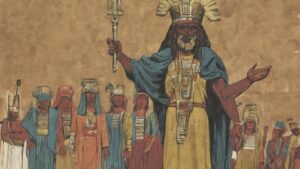Table of Contents
Animism is a belief system and a mythical concept found in many indigenous cultures around the world. It is a way of understanding and relating to the natural world and all its elements as being alive, conscious, and possessing spirits or souls. In animism, every living being, as well as natural phenomena like rocks, trees, rivers, and celestial bodies, is believed to have its own spirit or consciousness.
Key aspects of Animism
Spiritual Worldview: Animism is a holistic and spiritual worldview that sees the entire natural world as interconnected and filled with spiritual or animate beings. This includes not only humans and animals but also plants, inanimate objects, and even natural forces like wind or thunder.
Sacred Relationships: Animist belief systems emphasize the importance of maintaining harmonious relationships with the spirits of the land, animals, and the environment. This often involves rituals, offerings, and ceremonies to appease or communicate with these spirits.
Cultural Variations: Animism is not a single, unified religion but a broad category that encompasses numerous indigenous belief systems around the world. Each culture has its own unique animist practices and cosmology.
Ancestor Veneration: Many animist cultures also venerate their ancestors’ spirits, believing that they continue to play a role in the lives of their descendants.
Nature Worship: Nature, in all its forms, is often considered sacred in animist belief systems. This can lead to reverence for the land, plants, animals, and the elements.
Shamans and Spiritual Intermediaries: In many animist cultures, shamans or spiritual leaders act as intermediaries between the human world and the spirit world. They perform rituals, divination, and healing practices.
Mythical Beings: Animism often includes belief in mythical or legendary beings, such as nature spirits, guardian spirits, and other supernatural entities. These beings can vary widely among different cultures.
Oral Traditions: Animist belief systems are typically transmitted through oral traditions, storytelling, and rituals, rather than through written texts.
Animism is not a single, standardized religion but a diverse and culturally specific set of beliefs and practices. Animism has been a fundamental aspect of many indigenous cultures for thousands of years and continues to be practiced in various parts of the world today. It is a deeply rooted and profound way of understanding and relating to the natural world.
The Theories of Animism
Tylor’s Theory of Animism: Sir Edward Burnett Tylor, an influential 19th-century anthropologist, introduced the concept of animism in his book “Primitive Culture” (1871). He defined animism as the belief in spirits that animate the natural world. Tylor suggested that animism was the earliest form of religious belief and represented an evolutionary stage in the development of religion. He proposed that it emerged from dreams, experiences of hallucination, and the attempt to explain natural phenomena.
Psychological Theories: Some psychologists and cognitive scientists have explored animism from a psychological perspective. They argue that the human tendency to anthropomorphize inanimate objects and natural forces is a cognitive bias that leads to animistic beliefs. These theories suggest that attributing human-like qualities to non-human entities is an inherent aspect of human cognition.
Functionalism: Functionalism, a perspective in anthropology, views animism as fulfilling important functions within societies. Animistic beliefs can help explain natural phenomena, provide a sense of control or predictability, and establish social cohesion. In this view, animism serves practical and social functions.
Symbolism and Metaphor: Some scholars interpret animism as a system of symbolic language and metaphor. In this approach, animistic beliefs and practices are seen as symbolic representations of people’s relationships with the natural world. Belief in spirits and interactions with them are symbolic expressions of humanity’s connection to the environment.
Revitalization Movements: Anthropologists have observed the persistence of animistic beliefs within various societies, even as they interact with modernity and organized religions. Some indigenous groups have engaged in revitalization movements, reviving or adapting animistic practices as a response to social and cultural change. These movements can reflect the resilience and adaptability of animistic worldviews.
Post-Structuralist and Postmodern Theories: Some contemporary theorists have examined animism from post-structuralist and postmodern perspectives. They explore the complexities of animistic belief systems, the influence of colonialism and globalization, and the fluidity of animistic practices in the modern world.
Early Theories of Animism
Edward Tylor’s Theory of Animism: Sir Edward Burnett Tylor, a pioneering anthropologist in the late 19th century, is often credited with introducing the concept of animism to the academic world. In his work “Primitive Culture” (1871), Tylor proposed that animism was one of the earliest stages of religious development. He defined animism as the belief in spiritual beings or souls that inhabit not only humans but also animals and objects. Tylor believed that animistic beliefs arose from early attempts to explain dreams, trances, and other mysterious experiences. He saw animism as a key step in the evolution of religion, preceding polytheism and monotheism.
Herbert Spencer’s Theory of Animism: Herbert Spencer, a philosopher and sociologist, had a different perspective on animism. He believed that animistic beliefs and practices emerged from humanity’s general tendency to attribute consciousness and intention to the natural world. According to Spencer, the animistic view was an early and primitive form of religious thought.
Émile Durkheim’s Sociological Perspective: Émile Durkheim, a prominent sociologist, examined religion, including animism, from a sociological standpoint. In his seminal work “The Elementary Forms of Religious Life” (1912), Durkheim argued that religious beliefs, including animistic ones, served to create social cohesion and solidarity within a community. He viewed animism as a way to symbolize and reinforce collective consciousness and social order.
Lewis Henry Morgan’s Ethnological Studies: Lewis Henry Morgan, an American anthropologist, conducted extensive ethnological research in North America. His studies of Indigenous American societies contributed to early understandings of animism. Morgan observed that many Indigenous groups practiced what he called “totemism,” which he saw as a form of animism. Totemism involved the belief that people were related to and had spiritual connections with certain animal or natural symbols, called totems.
Early Theories of Evolutionary Development: Some early theories of animism were linked to broader theories of evolutionary development. Scholars like Tylor and Spencer placed animism within a framework of human cultural and intellectual evolution, suggesting that it represented an earlier and simpler stage of religious thought compared to later, more complex religious systems.
These early theories provided foundational concepts and discussions for the study of animism and religion in anthropology and related fields. Contemporary scholars have refined and expanded upon these early theories, recognizing the complexity and diversity of animistic beliefs and practices in various cultures. Animism remains an important area of study within anthropology, and modern perspectives continue to explore its significance and role in different societies.
Modern Viewpoint of Animism
The modern viewpoint of animism is characterized by a more nuanced and culturally sensitive understanding of animistic beliefs and practices. While early theories of animism often viewed it through the lens of evolutionary development and simplification of religious thought, contemporary perspectives emphasize the cultural and contextual richness of animistic worldviews. Here are some key aspects of the modern viewpoint of animism:
Cultural Relativism: Modern anthropology and religious studies emphasize cultural relativism, which means approaching animism and other belief systems without imposing external judgments or preconceived notions. Scholars respect the cultural context and interpretations of animistic beliefs within specific societies.
Diversity and Complexity: Contemporary scholars acknowledge the diversity and complexity of animistic beliefs. Animism is not a single, uniform system but a category that includes a wide range of practices and worldviews, varying from one culture to another.
Interconnectedness and Ecology: Many modern interpretations of animism emphasize its ecological and environmental dimensions. Animistic worldviews often stress the interconnectedness of all living beings and the environment. These perspectives highlight the importance of nature and the consequences of human actions on the natural world.
Continuity and Adaptation: In some cases, animistic beliefs and practices have continued to evolve and adapt to changing social, cultural, and environmental contexts. Modern animism may blend traditional practices with contemporary concerns and influences.
Indigenous Rights and Cultural Preservation: Animism is an integral part of the belief systems of many Indigenous peoples around the world. Advocates for Indigenous rights and cultural preservation work to protect and promote animistic traditions as valuable cultural heritage.
Interdisciplinary Approach: Contemporary research on animism often takes an interdisciplinary approach, drawing from anthropology, religious studies, environmental studies, and other fields. This interdisciplinary perspective allows for a more comprehensive understanding of animistic worldviews.
Respect and Collaboration: Researchers, practitioners, and advocates often collaborate with Indigenous and local communities to gain insights into animistic belief systems and to work together on cultural preservation and environmental conservation efforts.
Reevaluation of Early Theories: Modern scholars critically reevaluate the early theories of animism and their limitations. They recognize that the concept of animism was developed within a Eurocentric framework and may not accurately reflect the perspectives and beliefs of Indigenous and non-Western cultures.
Modern viewpoint of animism embraces diversity, complexity, and cultural context. It seeks to understand and respect animistic beliefs and practices on their own terms, recognizing their significance for the communities that hold them. Animism is no longer viewed solely as a primitive or early stage of religious development, but as a valuable and complex aspect of human cultural and spiritual diversity.
Examples of Animism
Native American Spirituality: Many Indigenous cultures in North America have animistic beliefs. For example, the Lakota Sioux have a strong belief in the spirits of animals and the land. Totemism, which involves reverence for and identification with animal totems, is another example of animistic belief found in Native American cultures.
African Traditional Religions: Several African traditional religions incorporate animistic elements. In Yoruba religion, practiced in West Africa and the Americas, the Orisha are spirits associated with natural forces, ancestors, and deities. In Vodou and Candomblé, animistic elements are combined with other religious traditions, creating syncretic belief systems.
Shintoism: Shintoism in Japan is characterized by animistic beliefs that emphasize the spiritual presence in natural elements. Shinto shrines often honor kami, spirits or deities that inhabit specific places, including mountains, rivers, and trees.
Traditional Indigenous Beliefs in Oceania: Indigenous cultures in the Pacific Islands, such as those in Papua New Guinea, have strong animistic beliefs. They believe in the spirits residing in the land, trees, and natural features, as well as ancestral spirits.
African and South American Amazon Rainforest Indigenous Beliefs: Indigenous peoples in the Amazon rainforest regions of South America and Africa often hold animistic beliefs. They believe in the spirits of the forest and its creatures and interact with these spirits through rituals, shamanism, and plant medicine ceremonies.
Siberian and Central Asian Shamanism: Various cultures in Siberia and Central Asia practice animistic shamanism. Shamans communicate with spirits, including those of animals, ancestors, and natural elements, to seek guidance and healing.
Australian Aboriginal Dreamtime: Indigenous Australian cultures have animistic beliefs related to the Dreamtime or Dreaming. These beliefs encompass creation myths, ancestral beings, and the interconnectedness of all life. The land and its features are considered sacred and inhabited by ancestral spirits.
Traditional Chinese Folk Religion: Traditional Chinese folk religion contains animistic elements, with beliefs in local deities, nature spirits, and ancestor worship. Sacred sites, mountains, and rivers are often considered inhabited by spirits.
European Folk Beliefs: In pre-Christian Europe, animistic beliefs were prevalent. Natural features, such as trees, stones, and bodies of water, were often associated with spirits. Some remnants of these beliefs persist in European folk traditions and folklore.
Contemporary Nature-Based Spiritual Movements: In modern times, there are neo-pagan and nature-based spiritual movements that draw inspiration from animistic beliefs. These movements often emphasize a deep connection to the natural world, respect for the environment, and rituals that honor the spirits of nature.
These are just a few examples of animistic belief systems found around the world. Animism continues to be a significant aspect of cultural and spiritual diversity, emphasizing the profound connection between humans and the natural world.
Animistic Way of Life
An animistic way of life is characterized by a deep and holistic connection to the natural world, a belief in the presence of spirits or consciousness in all things, and a set of cultural and spiritual practices that reflect this worldview. Here are some key aspects of an animistic way of life:
Interconnectedness: Animism emphasizes the interconnectedness of all living beings, natural elements, and the environment. It recognizes that humans are just one part of a larger web of life and that everything is interrelated.
Spiritual Presence: Animists believe that spirits or souls inhabit not only humans but also animals, plants, rocks, rivers, mountains, and other natural features. These spirits can be benevolent or malevolent and are often seen as having their own intentions and agency.
Respect for Nature: An animistic way of life is characterized by a deep respect for nature and the environment. Natural elements and landscapes are considered sacred and are often protected and preserved.
Rituals and Ceremonies: Animists engage in rituals and ceremonies to communicate with and honor the spirits of the land, ancestors, and other beings. These rituals may involve offerings, dances, songs, and prayers.
Ancestor Veneration: Many animistic cultures venerate their ancestors and believe that the spirits of the deceased continue to play a role in the lives of the living. Ancestral spirits are often consulted for guidance and protection.
Shamanism: In some animistic cultures, shamans or spiritual leaders serve as intermediaries between the human world and the spirit world. They perform rituals, divination, and healing practices and have a deep understanding of the spiritual realm.
Myth and Oral Tradition: Animistic cultures often have rich oral traditions that include myths, stories, and legends that explain the origins of the world and the relationship between humans and spirits. These narratives are passed down through generations.
Sustainable Practices: Animistic societies often practice sustainable ways of living in harmony with their natural surroundings. They respect the land and its resources, understanding that overexploitation can anger the spirits and disrupt the balance of the environment.
Cultural Identity: Animistic beliefs and practices are integral to the cultural identity of many Indigenous and traditional communities. They shape the way people interact with the world and with each other.
Modern Challenges: In a rapidly changing world, animistic cultures face modern challenges, including environmental degradation, loss of ancestral lands, and cultural assimilation. Efforts to preserve and revitalize animistic traditions are ongoing in many regions.
An animistic way of life is deeply rooted in a sense of place, a reverence for nature, and a belief in the spiritual dimensions of the world. It emphasizes the importance of living in balance with the environment and respecting the spirits that inhabit it.
Animistic religions

Animistic religions, also known as animism, are belief systems and spiritual practices that are centered around the idea that the natural world is inhabited by spirits, souls, or conscious entities. These spirits are believed to have a significant influence on the lives of humans and the environment. Animistic religions are typically indigenous and are often practiced by small-scale, traditional societies. Here are some examples of animistic religions from various parts of the world:
Shintoism: Shintoism is the indigenous religion of Japan and embodies animistic beliefs. Shinto shrines are dedicated to kami, which are spirits or deities associated with various natural elements, including mountains, rivers, and trees.
African Traditional Religions: Across the African continent, numerous indigenous cultures practice animistic religions. These belief systems often involve the worship of spirits, ancestors, and deities associated with nature and natural forces.
Native American Spirituality: Native American tribes have diverse animistic belief systems. Many emphasize the spiritual connections between humans and animals, the land, and natural elements. Totemism, the belief in spiritual connections with specific animals, is a common feature.
Australian Aboriginal Dreaming: Indigenous Australian cultures follow the Dreamtime or Dreaming belief system, which is animistic and involves creation myths, ancestral spirits, and the interconnectedness of all life forms with the land.
Siberian and Central Asian Shamanism: Various cultures in Siberia and Central Asia practice animistic shamanism. Shamans communicate with spirits to seek guidance, healing, and maintain the balance of nature.
Indigenous Amazonian Religions: Indigenous peoples of the Amazon rainforest have complex animistic belief systems. They believe in the spirits of the forest, its creatures, and the healing powers of plant medicine. Ayahuasca ceremonies are an example of animistic practices in the Amazon.
Traditional Chinese Folk Religion: Traditional Chinese folk religion includes animistic elements such as the veneration of local deities, nature spirits, and ancestral spirits. Sacred sites often represent natural features, like mountains and rivers.
Vodou and Candomblé: These syncretic religions in the Caribbean and Brazil combine elements of African animism with other religious traditions. They involve the worship of spirits and deities, often called “lwa” or “orisha.”
Contemporary Neo-Paganism: Some modern pagan and nature-based spiritual movements incorporate animistic elements. They emphasize a deep connection to the natural world, respect for the environment, and rituals that honor the spirits of nature.
These examples demonstrate the global diversity of animistic religions, each with its own unique cosmology, rituals, and practices. While animism may have common themes, it takes on a wide range of expressions in different cultural contexts, reflecting the profound relationship between humans and the natural world.
Animistic thinking
Spiritual Presence: In animistic thinking, the natural world is seen as inhabited by spirits or entities that have their own consciousness and intentions. These spirits can include those of animals, plants, rocks, rivers, celestial bodies, and even human-made objects.
Interconnectedness: Animistic thinking emphasizes the interconnectedness of all things. It recognizes that humans are part of a larger web of life and that everything in the environment is interrelated. Actions toward one part of the natural world can affect the whole.
Agency and Intent: Animistic thinking attributes agency and intent to the spirits inhabiting natural elements. These spirits are believed to have their own desires, emotions, and motivations. Human interactions with these spirits often involve negotiation and respect.
Ritual and Communication: Animistic thinking leads to the development of rituals and practices for communicating with spirits. These rituals may include offerings, prayers, dances, and ceremonies to establish and maintain a relationship with the spiritual world.
Respect and Reverence: Animistic thinking is marked by a deep respect and reverence for the natural world. This respect is not solely based on utility but on the understanding that nature is sacred and deserving of protection and preservation.
Myth and Storytelling: Myths, stories, and legends play a significant role in animistic thinking. These narratives often explain the origins of the world, the relationships between humans and spirits, and the moral values of the culture.
Shamanism and Spiritual Leaders: Animistic societies may have shamans or spiritual leaders who act as intermediaries between the human and spirit worlds. Shamans often use their connection to the spirits for healing, divination, and guidance.
Ancestor Veneration: Many animistic cultures practice ancestor veneration, believing that the spirits of the deceased continue to play a role in the lives of the living. Ancestral spirits are often consulted for guidance and protection.
Sustainable Living: Animistic thinking often leads to sustainable and environmentally conscious practices. It recognizes the need to live in harmony with the environment, as disruptions in the natural world can have spiritual and practical consequences.
Cultural Identity: Animistic thinking is a fundamental aspect of the cultural identity of many Indigenous and traditional communities. It shapes their worldviews, ethics, and social structures.
Animistic thinking is deeply rooted in a sense of place, a reverence for nature, and a belief in the spiritual dimensions of the world. It is a way of understanding and interacting with the environment that reflects the profound connection between humans and the natural world.
Animism FAQ
What is Animism Religion?
Animism is not a formalized religion but a cultural and spiritual perspective found in various indigenous and tribal traditions worldwide.
Where is Animism Practiced?
Animism is practiced globally, notably among indigenous communities in Africa, Asia, the Americas, and Oceania.
What do Followers of Animism Believe?
Animists believe in the spiritual essence of natural entities and their influence on human life, emphasizing the interconnectedness of all elements in the natural world.




